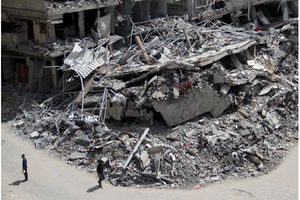What happened to plan to set up youth workplaces?

Youth in Karamoja crush stones to earn a living in Kosiroi Village, Tapac Sub-county in Moroto District. Many youth fail to work because they do not have work stations. PHOTO BY STEVEN ARIONG
The promise:
In the run up to the 2011 general election, the ruling National Resistance Movement (NRM) party chairman and presidential candidate, Mr Yoweri Museveni, reinvented himself to have a bigger appeal with the more youthful sections of the voting community by releasing a rap song, “Do you want another rap?”
The party also released a manifesto in which it committed itself to making six interventions that it said would “empower the youth to become job creators and not job seekers”.
One of the six was to implement a policy that would see the government, through the Ministry of Gender, Labour and Social Development, open up several youth workplaces and sites in diverse parts of the country.
The other interventions included, among others, the attraction of more investors, creation and opening of business parks in various parts of the country and setting up a youth enterprise start-up fund.
By the time the manifesto was released, Uganda had an estimated population of 33,149,416 people and was growing at the rate of 3.2 per cent per year, according to Uganda Bureau of Statistics (UBOS).
There were already indicators that the country was destined to have the world’s youngest population.
That was confirmed by the 2014 National Housing and Population Census which put the population of people below the age of 30 years at 78 per cent.
It was also becoming increasingly clear that the country would have challenges in meeting the needs of its young population. Much as the economy was growing at the rate of 7 per cent per year, it was clear that formal job creation was not keeping in pace with increase in the population.
Unemployment had risen from 1.8 per cent in 2008 to 2.8 per cent in 2009 before shooting up to 3.1 per cent in 2010, according to the World Bank report.
The problem was not being helped by underemployment and informality.
With the African Development Bank’s (AfDB) Partnership Forum having put the rate of unemployment at 83 per cent and the World Bank putting youth unemployment in Kampala alone at 32.2 per cent, it was clear that Uganda was destined to have one of the highest unemployment rates in Sub-saharan Africa.
Government had, of course, been trying to address itself to issues around unemployment.
In 2009, it moved to stimulate the economy by announcing tax relief for the education, health services, agro-processing and hotels sector.
During the same period, it had made available to Enterprise Uganda Shs1.5 billion to enable it embark on training youth in business and entrepreneurship.
It had also handed Uganda Investment Authority (UIA) Shs1 billion for it to establish a Small and Medium Enterprises (SME) desk.
Uganda was at the time estimated to be having 800,000 SMEs believed to have been providing employment to about 2.5 million people.
The SME sector was also believed to be growing at a rate of 20 per cent per year, which made policy makers believe that if it were to be strengthened, it would help in the absorption of many of the unemployed youth.
Against such a background, the promise to set up workplaces and sites for the youth made quite a lot of sense.
It was another opportunity of empowering the youth to go into production, facilitate skills development and provide them with livelihood support, all of which would have fitted in well with the agenda of addressing unemployment among the youth and enabling them to have access to well-equipped work areas from which they would derive an income.
There was no blueprint of what the work areas were meant to look like, but if other organised artisanal work spaces are anything to go by, the shelters were meant to be fitted with electricity and running water and equipped with basic working tools to facilitate mostly work of a vocational nature.
They would mostly likely have been able to produce stuff such as furniture, arts and crafts and also had cooking areas and eateries, all of which would have created numerous placements in direct and indirect employment.
Nine years and four months after the promise was made, the shelters have not been put in place. So what happened?
Official Position
The Commissioner for Youth in the Ministry of Gender, Labour and Social Development, Mr Mondo Kyateka, told Daily Monitor that attempts had been made to work towards realising the promise, but that the process broke down because the Ministry of Finance, Planning and Economic Development never made the funds available
“The ministry had started a sheltered workplace in Makindye (in Kampala), but the project collapsed due to lack of funds. Had it been successful, we would have used it as a model to roll out to other divisions of the capital city and later other towns and districts, but it did not,” he said.
He said the sheltered workplaces project was at a later stage taken over by Kampala City Council Authority (KCCA). The project has, however, not been rolled out into all the divisions of the city.
KCCA’s one-stop youth centre based in Kabalagala in Makindye Division equips youth with life skills and gives hands-on training in among others, leather tanning, electrical repair and installation, hair dressing and cookery.
Impact
Earlier parts of the same manifesto indicated that the policies that were laid out for implementation with special focus on the youth were for purposes of, among others, promoting the social and economic empowerment of the youth and promoting growth in the development of the youth through actions that protect, empower and prepare them for the future.
The promise to create these work places was in line with those purposes.
They would have helped to keep sections of the youths engaged in activities that would have kept them off the streets where most of them have been idle.
This idleness had partially been to blame for the rise in both petty and violent crimes, especially around Kampala and other major towns.
This redundancy is also partially responsible for the rise of groups such as the Jobless Brotherhood.
The Jobless Brotherhood became famous for dropping yellow piglets at Parliament and on the streets of Kampala city and other towns to protest government’s failure to address various issues, including unemployment, corruption, abuse and waste of public resources through a bloated public expenditure.
Even in the villages, it is not strange to find idle youth in many of the trading centres playing cards and gossiping.
This has left them looking at sports betting as the best way of earning money even when they know it is not.
The promise was also meant to partially address the question of unemployment among the youth and providing some of them with sources of income. That has not happened.
If anything, the unemployment problem among the youth has been growing.
In 2016, the Uganda Bureau of Statistics (UBOS) revealed that 90 per cent of Ugandans under 25 years of age were unemployed and 58 per cent of total population unemployed. Whereas it had dropped from 5.9 per cent in 2010 to 2.7 per cent in 2013 and 2014, it rose to 2.71 per cent in 2015, 2.82 in 2016 and 2.91 per cent in 2017.
MONITOR POSITION
The problem of youth unemployment needs to be addressed in a systematic manner. There is an urgent need for government to address the inconsistencies between the national youth policy and the national development agenda.
Right now the two are more focused on the politics than the labour and unemployment challenges of the country.
This perhaps explains why while there has been no money to bankroll various programmes meant for the youth such as the Youth Business Linkage programme through which large companies were meant to be given special incentives whenever they would do business with youth-led enterprises and where youth led businesses were meant to be supported to enter the market and grow; the Youth Internship Program which would have seen government encourage internships for youths at various tertiary institutions; and the national youth service, there has always been enough money for the politics to go on.
This can be seen from the haphazard interventions in the form of cash handouts which President Museveni has been making over the last eight years. For example in April 2013, he took a sack of Shs250million and handed it to the youths in Busoga region. Last year NRM youths in Kampala were the recipients of donations to the tune of Shs3.2billion while 110 groups in Rukungiri bagged money, trucks, omnibuses and an assortment of machinery worth over Shs5 billion.
The impact of those interventions on the individual members of the groups or the groups and areas where they are based is quite difficult to quantify, but in the case of the youth groups in Busoga, there is need for government and President Museveni to reconsider his approach.




